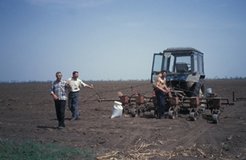Land reform in two former republics of the Soviet Union: Georgia and Ukraine
Land reform in two former republics of the Soviet Union: Georgia and Ukraine
Land Reform in Ukraine
Entitlement to land in Ukraine was also determined by type of previous employment: kolkhoz/sovkhoz or in the non-agricultural domain of the village.
The amount of land received by ex-kolkhoz/sovkhoz workers varies from place to place depending on the amount of land and number of members in the former agricultural collective. In the district capital of Reni, ex members received 7 ha, in village Nagorna less, since land there is less plentiful. A national limit for non-agricultural rural workers was set at a maximum of 2 ha. Unlike in Georgia, however, in Ukraine entitlement is not complicated by household issues. It is individuals who are entitled to this land. The number of titles owned by a household depends on the number of people in the house and where they worked. Apart from the privatisation of kolkhoz and sovkhoz land, villagers are also entitled to a maximum of 1 ha for the purposes of a household plot.
Land in Ukraine is worked collectively: most often by cooperatives that have developed from the liquidated kolkhozy and sovkhozy but also by informal groups of non-agricultural rural workers. Private farmers rent land from family and non-family villagers, attracting land owners by offering more lucrative rent than the cooperatives.
Case Study
The village of Nagorna, Odessa Oblast, has a population of 3642 and approximately 1000 houses with a total land area of 7237 ha. In Nagorna five cooperatives have replaced the Soviet collectives, with ex-kolkhoz members receiving 3.45 ha and former sovkhoz workers 4.10 ha. Non-agricultural workers with 0.5 ha each have formed a number of informal groups. There are also approximately 10 private farmers who rent land from other villagers. The farm sizes vary; the largest is approximately 170 ha. In my other comparative project I give an example of a private farmer in Nagorna . Here I give the example of a cooperative.

Currently the overwhelming majority of Nagorna land is worked by successor enterprises to the collective farms. Indeed for most villagers it makes no economic sense to start farming one's own land: the costs are too high, technology too expensive and the land not enough. The former kolkhoz is now four private cooperatives. All four cooperatives are involved in crop production, mainly grains, and are expanding their vineyards; livestock from the previous kolkhoz was liquidated. The previous head of the kolkhoz runs one of the cooperatives called 'Avante Gard' (the head agriculturalist, the previous head engineer run two of the others). It has 176 members and cultivates 440 ha of land. The leader of Avante Gard works closely with two of the other cooperative leaders (the fourth remains aloof and independent). The three leaders take decisions concerning planting jointly, and buy seeds and fuel together. Most of the machinery - tractors, combines and so on - has been preserved, and although old is still in working order. Members are paid the same amount of annual rent, which amounts to approximately 1 tonne of a variety of grains (predominantly wheat), but is dependent on the harvest in any particular year.
Problems in the Ukrainian case vary, depending on the type of organisation. Cooperative members complain that the organisations are not run democratically. Members accuse cooperative leaders of mismanagement of resources and indeed controls are hard to enforce given the fact that the leaders form a closed, elite group. There are clear tensions between the three heads who share the same work practices, and the fourth, who pays his members a different rent, inevitably causing friction between villagers.
